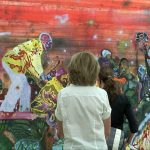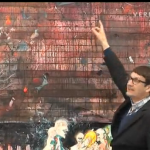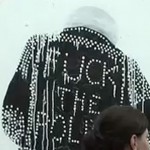The exhibition ”Daniel Richter: Stupor” at Thaddaeus Ropac in London presents new paintings by the German artist Daniel Richter. For his second solo show at Thaddaeus Ropac in London, he presents a group of paintings that portray biomorphic forms in a series of twisting poses. Daniel Richter’s latest works are influenced by music and countercultures. Richter draws inspiration from Hanns Eisler’s song ‘Nightmare’ as a response to McCarthyism, reflecting historical parallels in his politically charged artwork. Daniel Richter: Stupor at Thaddaeus Ropac in London runs until December 1, 2023.
Daniel Richter: Stupor / Thaddaeus Ropac, London Ely House, London (UK), Press preview, October 10, 2023.
–– Right-click (Mac: ctrl-click) this link to download Quicktime video file.
Press text:
The rat men accused me of not liking stench,
of not liking garbage, of not liking their squeals,
of not liking to eat dirt. For days they argued,
considering the question from every angle,
finally they condemned me.
You don’t like stench, you don’t like garbage,
You don’t like our squeals;
You don’t like to eat dirt.
— Hanns Eisler, ‘Nightmare’ from Hollywooder Liederbuch (1938–48)
An exhibition of new work by Daniel Richter reasserts the German artist’s ever-inventive approach to depicting the human body. For his second solo show at Thaddaeus Ropac in London, he presents a group of paintings that portray biomorphic forms in a series of twisting poses.
Music and its countercultures have been of deep importance to Richter throughout his life, and their influence is felt in much of his work. ‘Nightmare’, a song by the German-Austrian composer Hanns Eisler (1898–1962), stands as a touchstone for this new group of paintings. Taken from Eisler’s monumental cycle of songs the Hollywooder Liederbuch (Hollywood Songbook; 1938–48), ‘Nightmare’ describes the composer’s enraged response to his persecution by the US House Un-American Activities Committee, following his emigration from Germany to Los Angeles. Against the backdrop of McCarthyism and fuelled by a fear of alleged Soviet influence in the United States, Eisler was erroneously charged for holding communist sympathies, ultimately prompting him to leave the country. The lyrics of ‘Nightmare’ brand the committee members ‘the rat men’ in a critique of the composer’s unjust treatment and the wider governmental suppression of left-wing intellectuals and artists.
‘The Eisler song is a sarcastic and bitter reminder that current events have their historic precursors,’ notes Richter. Choosing to illustrate his political concerns in an indirect manner, in these paintings the artist offers a turbulent treatment of the body. Sweeps of paint exceed the black lines of the figures, undermining the cohesion of the human form and suggesting its potential vulnerability to external forces as he oscillates between modes of abstract and figurative expression.
Since 2015, Richter has broken down compositional distinctions between background, foreground and subject to create renditions of the body in metamorphosis. While previous series of paintings drew upon visual source materials as diverse as pornography and a historic postcard of injured World War I soldiers, this new group of paintings echoes Richter’s observations of the world around him. As he describes, ‘it’s based on random sketches and notes, [an] old woman passing by, [a] child at the dentist, boys playing basketball, stuff like that.’ Appearing alone or in small groups, these knotted figures are articulated using strong, graphic black lines. Limbs, facial features and hunched torsos come in and out of focus amongst a swirl of brightly-coloured smears of paint. Set within vibrant red environments, the contorted forms that populate these works vibrate with an energy imparted through the artist’s bold palette and dynamic mark-making.
Understanding change to be an essential component for artistic evolution, in this exhibition Richter continues his stylistic experimentation with the flat backdrops of his earlier works. Here, his figures are depicted against a grey background that is then almost entirely covered by a layer of bright red paint, isolating the bodies within a sea of vibrant colour. In so doing, he reverses the painting process, laying down the background as one of the final stages of the work. Endlessly seeking new approaches to painting within his practice, he notes, ‘I think it’s good to change. I had milked the cow, now I am riding the pig.’ Embodying this investigative approach to artmaking, these works are as much experiments in colour, line and technique as figurative studies, carving out a distinct place within the artist’s wider oeuvre and the landscape of contemporary painting itself.
Born in Eutin, Germany, Daniel Richter lives and works in Berlin. He studied at the Hochschule für bildende Künste Hamburg from 1992–96 under Werner Büttner, and later worked as an assistant to Albert Oehlen. Comprehensive solo exhibitions of Richter’s work have been held at Kunsthalle Tübingen (2023); Space K, Seoul (2022); TAXISPALAIS Kunsthalle Tirol, Innsbruck (2014); Schirn Kunsthalle Frankfurt (2014); Kestner Gesellschaft, Hannover (2011); CAC Málaga and Denver Art Museum (both 2008); Hamburger Kunsthalle (2007); National Gallery of Canada, Ottawa (2005); and Kunstsammlung Nordrhein-Westfalen, Düsseldorf (2001).
Between 2016 and 2017, a major monographic exhibition of the artist’s work travelled to the Louisiana Museum of Modern Art, Humlebæk, 21er Haus (now Belvedere 21), Vienna, and Camden Art Centre, London. More recently, Richter’s work was shown in the landmark group exhibition Radical Figures: Painting in the New Millennium at the Whitechapel Gallery, London (2020). In 2022, a solo exhibition was held at the Ateneo Veneto, Venice, coinciding with the 59th Venice Biennale and, in 2023, a major monographic survey of the artist’s career was presented at Kunsthalle Tübingen.







